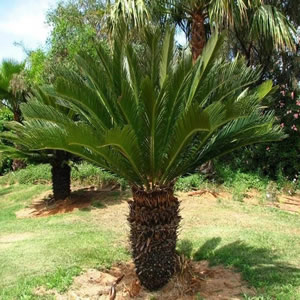GreenCare Hand Sanitizer
- BIZ OP
- 08:00 PM, Feb 02
|
When left to grow in its natural shape, the branches will elongate beyond the central body. An annual trimming of protruding stems will keep a neat yet natural-like form, a cone shape. Blue Point Juniper makes a good windbreak or privacy screen. Plant 4'- 6' apart to form a full hedge row. Densely branched blue -green. Junipers are subject to spider mites, may need to be sprayed from time to time. Spraying with a heavy stream of water may reduce the number of mites on a plant. Juniper is an intermediate host for apple rust which can transfer to pyracantha.
Width Range: 2-6 Feet
Height Range: 8-12 Feet
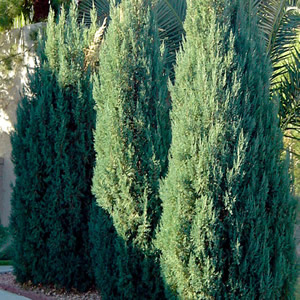
Bright to medium green, heart-shaped leaves and brightly colored flowers. Comes in a range of flower colors. Twiggy thorns appear along the length of the canes. Extremely frost sensitive. Give minimal water in winter and plant in a location which will protect it from our colder winter temperatures, either insulated by surrounding plants or a west facing wall that will radiate heat. Damaged branches need to be removed each spring sometimes 12 inches from the ground. Very sensitive rootball, cut away plastic container when planting to minimize root damage.
Width Range: 4-6 Feet
Height Range: 4-10 Feet
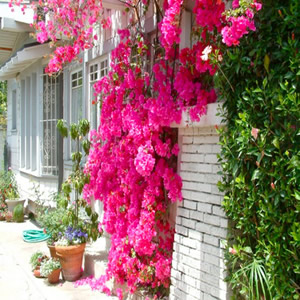
This shrub is smaller, with a denser growth habit, then the other euonymus on our list. The glossy, leathery, medium to dark green leaves have the scallop-toothed margins common among euonymus, but are also of a smaller size. Prefers afternoon shade, well-drained amended soils and organic surface mulch. Can take significant sun in our area with proper soil and enough water, but is not generally as healthy. Takes well to trimming and shaping, but can also be left natural. Good for low hedges and borders and is often used as a hardier substitute for Japanese Boxwood. Synonym: Euonymus japonicus 'Microphyllus'.
Width Range: 1-3 Feet
Height Range: 1-3 Feet
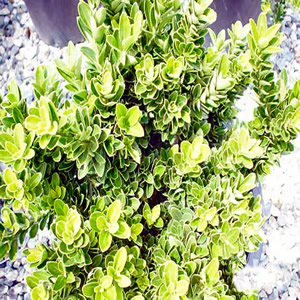
A mounding shrub with silver-gray to silver-green, silky, lance-shaped foliage. Masses of white morning glory flowers with yellow centers cover this plant in spring and summer. Buds have a pink tint and this can occasionally carry over into the open blooms. Can be a short lived shrub in Las Vegas and will die quickly if it doesn't like its location. Established plants will live several years, sometimes longer. Fertilize in spring. Drought tolerant. Can take reflected heat, but also welcomes some light shade in our low desert climate. Trim for shape in fall if it starts becoming leggy. Be sure to reduce its water in winter or it may rot.
Width Range: 3-5 Feet
Height Range: 1-3 Feet
Seasonal Habit: Evergreen
Growth Rate: Fast
Maintenance Level: Low
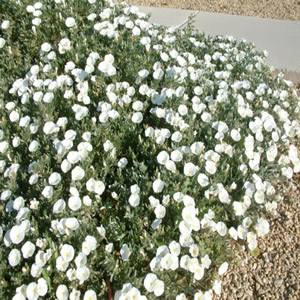
Brilliant orange flowers appear for long periods during spring and fall and are great humming bird attractors. Requires regular pruning to maintain shape. Cut back water in fall to help harden off plant to minimize frost damage, usually comes back from roots if frost killed. Plant in spring to help get plant established for the winter. Need support and careful pruning to grow as a vine. Synonym: Tecomaria capensis
Width Range: 3-7 Feet
Height Range: 6-10 Feet
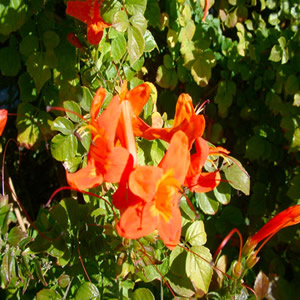
Mounded, sprawling form. Oblong, medium green leaves. Clusters of white or pale to medium blue flowers, depending on cultivar. Blooms intermittently spring to autumn. Leaves and flowers both slightly sticky. Prune for shape in late winter to encourage bushiness. Spreads by suckering. May die back in severe cold, but generally recovers quickly. Best as foundation plant or large-scale groundcover. Synonym: Plumbago capensis
Width Range: 3-10 Feet
Height Range: 3-10 Feet
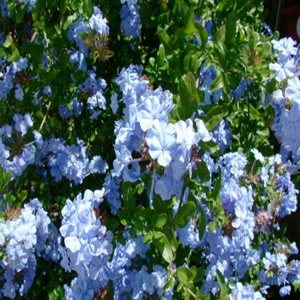
Much the same characteristics as Myrtus communis, but in dwarf form. Smaller leaf and mature size. More commonly found in local nurseries than the full-size version. Also comes in a variegated form.
Width Range: 2-6 Feet
Height Range: 2-6 Feet
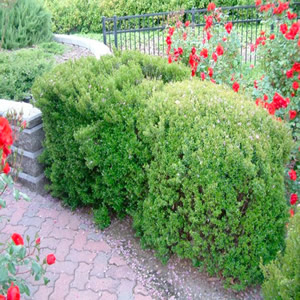
Compact dense growth, flowers appear in masses with wide spread irrigation and humidity. Be careful not to overwater, provide good drainage. Avoid heavy trimming and sheering branches. Allow enough room for mature growth.
Width Range: 3-7 Feet
Height Range: 3-7 Feet
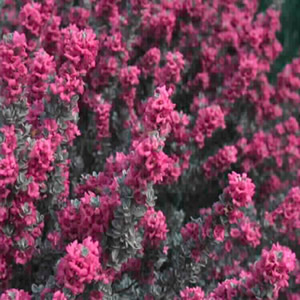
Southwestern native. Clumping ornamental grass. Rounded, mounding habit. Bright green to gray-green, thin foliage. Long, narrow, spikes of straw-yellow to tan flowers mature to tan to brown seeds. Seeds are a food source for birds. Turns partially or fully yellow in winter. To renew growth cut down to around 3 to 5 inches above the ground in late winter or early spring. May brown out in summer if given insufficient water.
Width Range: 2-6 Feet
Height Range: 2-6 Feet
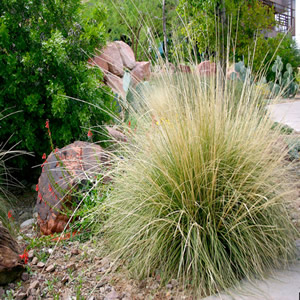
Dusty Miller is mainly grown for its attractive grey foliage. At night the reflection of the moon of its leaves can give dramatic effects. Use as border plantings, around patios, mixed in with wildflower gardens or as container plants. Plants should have good drainage, protect from hard frosts.
Width Range: 1-2 Feet
Height Range: 1-2 Feet
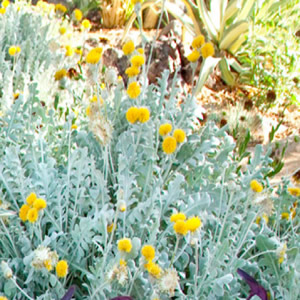
Small shrub with a spreading, round to irregular habit. Narrow, fuzzy, blue-green to gray-green, lanced-shape leaves. 'Brushes' of bright to deep red, puff-like flowers appear near the tips of the branches. Small, woody, brown to black seed capsules follow. Prefers organic surface mulch. May become chlorotic if overwatered or in high alkaline conditions. Requires little to no pruning. Slightly cold sensitive in our area. Synonyms: C. citrinus 'Little John', C. viminalis 'Little John'.
Width Range: 2-4 Feet
Height Range: 1-3 Feet
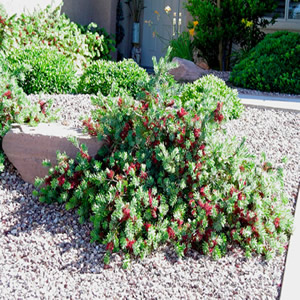
Much like the Pittosporum tobira. Main difference is its compact, low mounding habit. Slightly less cold hardy than P tobira
Width Range: 3-4 Feet
Height Range: 2-3 Feet
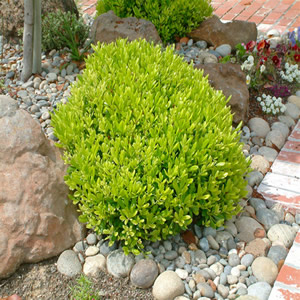
Much of the same characteristics as Nandina domestica with a smaller mature size. This is one of several dwarf cultivars of N. domestica. Other cultivars include N. d. ' Harbour Dwarf' which is 3 feet tall and spreads by rhizomes, N. d. 'Nana' at 2 x 3 feet, and N. d. 'Nana Purpurea' at 2 x 3 feet with a purple cast to the foliage.
Width Range: 3 Feet
Height Range: 4 Feet
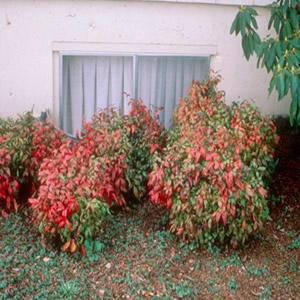
All parts are poisonous if ingested, don't burn prunings, smoke can cause severe irritation to the mucous membranes. This is an extremely hardy plant, take very little water once established. Makes a quick hedge, wind barrier or sight break. Does not do well in the shade. Varieties include Mrs. Roeding: double salmon-pink flowers grows 6' tall and has smaller leaves; Petite Pink and Petite Salmon grow 3-6 feet tall and as wide, can be kept at the lower end with pruning; Sister Agnes: a single white flower and the most vigorous grower, often reaching 20 feet.
Width Range: 3-7 Feet
Height Range: 4-8 Feet
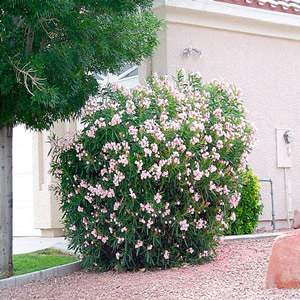
Dwarf Pomegranate Has the same characteristics as the standard pomegranate, in dwarfed form. The mature size, leaf, flower, and fruit size are all smaller than the standard. Fruit on the 'Nana' is primarily ornamental.
Width Range: 3 Feet
Height Range: 4 Feet
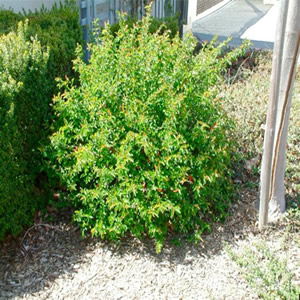
Dwarf Yaupon holly Has leathery dark green leaves, which have extremly high cafine levels and if ingested could induce vomiting, thus the species name vomitoria. Drought tolerant.
Width Range: 1-5 Feet
Height Range: 1-5 Feet
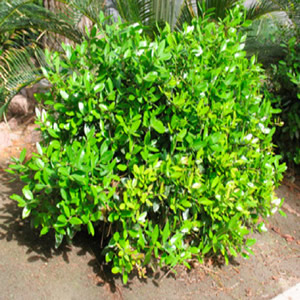
This hybrid variety is more commonly found in our area then Elaeagnus pungens. Hybrid of E. pungens and E. multiflora. Looks very similar to E. pugens, but with a more upright form, a somewhat smaller upper size range, and no spiny tips on the branches. Glossy, elliptical, deep green leaves are covered in small silvery dots, giving it a rough texture, and have pale silvery undersides and wavy margins. Tiny, cream colored, bell-shaped flowers may go unnoticed, but their sweetly spicy fragrance is delightful. The small red-brown fruits have an interesting texture and are enjoyed by birds. Accepts sun but is also highly shade tolerant. Benefits from afternoon shade in our area. Accepts most soil types, but prefers lightly amended soils with good drainage. Fertilize lightly spring and autumn for best appearance. Very alkaline soils can cause nutrient deficiencies, but are easily corrected with applications of soil sulfur and kerex. Good choice for a hedge, screen, or background planting. Give plenty of room to reach its mature size. Accepts pruning but do not shear as it will become overly woody and the leaves are large enough that partial leaves are very noticeable. Several variegated cultivars available.
Width Range: 6-10 Feet
Height Range: 6-10 Feet

This broadleaf evergreen shrub has glossy, leathery, medium to dark green oval leaves with scallop-toothed margins. Naturally forms a dense, oval mound, but can be pruned for a more formal look. Grown for its foliage. Flowers and seeds are sporadic and insignificant. Good for hedges and barrier plantings, also sometimes used for topiaries. Prefers afternoon shade, well-drained amended soils and organic surface mulch. Can take significant sun and poor soils, but is generally unhealthy in such conditions in our area. Can be pruned year round; however, when removing a lot of vegetation, it is better to do so in winter as the Euonymus is susceptible to sunburns. Synonym: Euonymus japonicus. Many cultivars available.
Width Range: 4-8 Feet
Height Range: 4-8 Feet
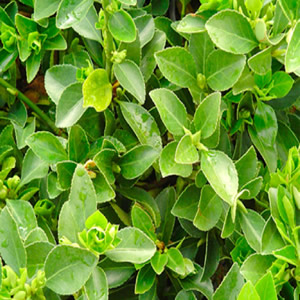
Multistemmed, arching branches with small dark green leaves. White to pale pink, tubular flowers. Generally evergreen in our area, but may loose leaves in severe cold. Leaves often turn bronze or bronze-edged green in winter. Prune selectively and avoid shearing. Can be trained into a hedge.
Width Range: 4-6 Feet
Height Range: 4-6 Feet
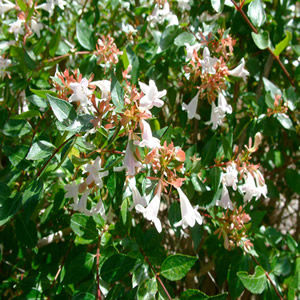
Hollow green canes of about 1-2 inches diameter. Leaf-baring stems grow from joints with fan-like clusters of narrow green to yellow-green leaves. Joints at the base are crowded and misshaped. Young canes have sheaths which fall off as they mature. Mature canes turn yellow if exposed to direct sunlight. Fast growing once established. Seldom flowers. Spreads by underground rhizomes. Can fill in and spread rapidly. Often used for screens and hedges. Potentially invasive. To keep this plant from spreading beyond the desired area, plant in containers or create an in-ground barrier (metal, fiberglass, concrete) at least 18 inches deep.
Width Range: 8-12 Feet
Height Range: 13-17 Feet
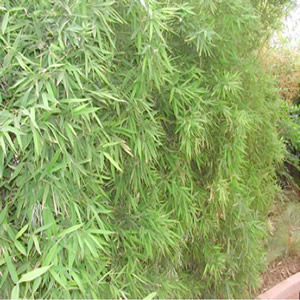
Dense, mounding to spreading habit. Leaves are oval to oblong, glossy, leathery, and dark green with lightly serrated edges. New growth has a bronze cast. Many cultivars available with flower colors varying from white to deep pink. Flowers cluster at the branch tips and attract bees. Dark blue to purple berries are a food source for birds. Prune regularly, preferably after flowering, to maintain dense habit. Shearing can ruin the look of this plant. Prefers enriched, acid soils. Can become chlorotic in our more alkaline soils. Does best with some shade in the low desert. Tends to leaf burn from heavy afternoon sun, reflected heat, and our hot summer winds. Susceptible to aphides, leaf spot, and scale.
Width Range: 2-5 Feet
Height Range: 2-4 Feet
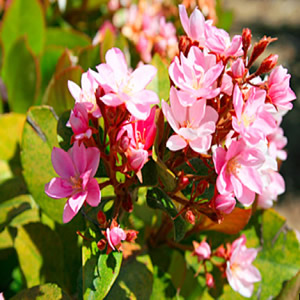
Excellent plant for hedges or screens, takes pruning well. May sunburn in hot areas, make sure plant has good drainage.
Width Range: 6-10 Feet
Height Range: 6-10 Feet
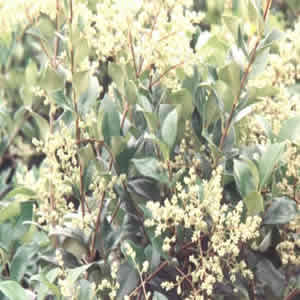
Most lantana are hybrids of Lantana camara and Lantana montevidensis. Lantana berries are poisonous. Lantana goes dormant in the winter and needs to be cut back to about 6 inches in late February or when there is no more threat of frost. There are many different varieties that grow as ground covers or shrubs. Lantana montevidensis is a purple blooming ground cover that is one of the most cold hardy, it blooms earlier in spring and later into the fall then the other varieties. Lantana montevidensis 'White' is a white flowering groundcover. Lantana 'New Gold' is one the best gold-yellow varieties that also stays low like a ground cover. 'New Gold' also has heavier blooming than the other varieties since it doesn't produce seed. Lantana 'Christine' is a shrub hybrid that yellow and magenta flower clusters. Lantana 'Radiation' is another shrub variety with orange and yellow flower combinations.
Width Range: 4-8 Feet
Height Range: 6-18 Feet

Medium to large size shrub or can be trained into a small tree, often with a slightly droopy appearance. Narrow, 3-inch long leaves come in coppery, mature to a bright green, and have a lemony scent when bruised. Long 'brushes' of bright red, puff-like flowers appear near the tips of the branches. Followed by small, woody seed capsules that persist on the plant. Prefers organic surface mulch. May become chlorotic if overwatered or in high alkaline conditions. Many cultivars available, varying in size and flower color (shades of red and pink).
Width Range: 6-10 Feet
Height Range: 6-10 Feet
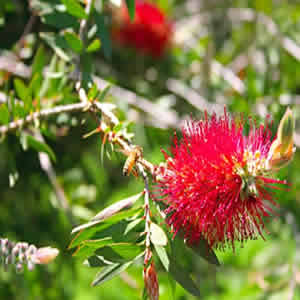
Differs from other, related, desert Birds of Paradise commonly seen in our area (C. gilliesii and C. pulcherrima). Has a lusher appearance. Leaves are larger, less airy, and have larger, rounded, leaflets. Clusters of smaller, bright to lemon yellow flowers without showy stamens. Blooms throughout the warm months and has very high heat tolerance. Seed pods can be messy and seeds and pods are toxic if ingested. Needs infrequent deep watering. Trim if compactness or a tree-like form is desired. Generally evergreen in our area, but may become deciduous in extreme cold.
Width Range: 4-8 Feet
Height Range: 10-12 Feet
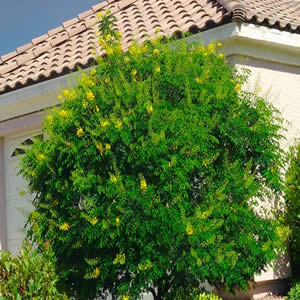
Grown for foliage. Do not overwater. Mexican feather grass can look stunning with its waving blonde heads nodding in the breeze. However, it can be an aggressive reseeder in an irrigated garden and won't stay where you plant it. Also sold as Stipa tenuissima
Width Range: 1-3 Feet
Height Range: 1-3 Feet
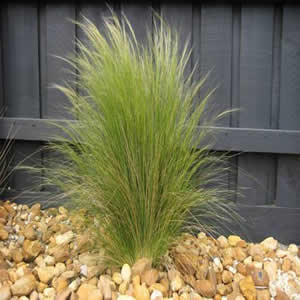
The Sago Palm has become a very popular landscape item and is the most common cycad used in landscape today. But most people don't realize that it is not a palm at all. Rather this plant is a Cycad, a totally different type of plant. There are over 200 different types of cycads. Cycads are a group of plants that are very primitive in their origins. Fossils have been found on almost every continent on the planet. It is often stated that cycads have evolved little since the days of the dinosaurs. There are species that have gone extinct, while there are others that seemed to show little evolution over millions of years. Therefore as a group, cycads are often referred to as "living fossils". The scientific name for the Sago Palm is Cycas revoluta.
